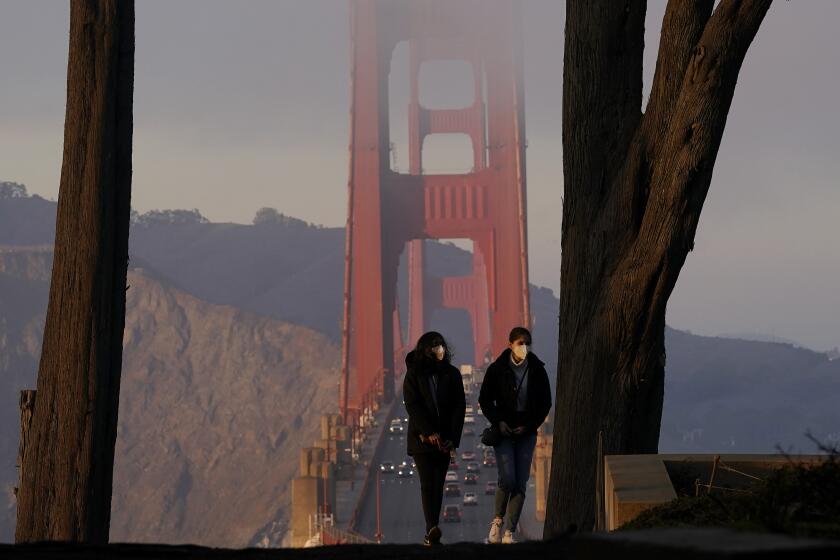Incumbents in California could face reelection challenges under draft congressional maps

- Share via
Several California members of Congress could face uphill battles to remain in office under draft political maps released Wednesday, with some incumbents drawn into the same districts and others possibly forced to run in areas where their party trails in voter registration.
The political muscle of Latino voters appears to be strengthened under the California Citizens Redistricting Commission’s proposed maps — a reflection of demographic changes in the state since the current congressional and legislative districts were drawn a decade ago. More than a dozen congressional districts were mapped to include significant Latino voting populations.
Commissioners conceded that the maps were imperfect and will likely change notably in the coming weeks.
“I have a laundry list of areas that I think will need a lot of refinement,” said Commissioner Sara Sadhwani.
Many details about the proposed districts were difficult to discern because of the lack of information released by the commission before their unanimous vote Wednesday evening to approve them. Low-resolution draft maps that staff members posted online were hard to read and the district lines were covered with large titles, leaving political boundaries for large swaths of Los Angeles and Orange counties a mystery. Higher-resolution maps were posted in the evening, giving the public little time to examine them before the vote.
After creating equal-sized congressional districts of about 761,000 people, the commission’s next priority is abiding by the Voting Rights Act to make sure minorities are not disenfranchised. However, data about racial and ethnic breakdown of eligible voters per district weren’t released before the vote.
“How can they say the VRA is being honored with that level of detail? You can’t,” said GOP redistricting expert Matt Rexroad. “The whole process is supposed to be open and transparent.”
The approval of the draft maps by the 14-member independent commission kicks off a two-week window for public review. Final maps must be submitted to state elections officials before the end of December — a process that was pushed back by more than three months after a historic delay in final census data. Candidates must file for office by mid-March with primary elections held in June.
The commission’s work to redraw districts for the U.S. House of Representatives carries implications far beyond the state’s borders. For the first time in history, California is losing a congressional seat because the 2020 U.S. Census showed it did not grow as fast as other regions. The state’s delegation, which will have 52 members after the 2022 midterm election, will remain the largest in the nation.
The U.S. Census Bureau released apportionment data, but the pandemic-induced lag has already caused ripple effects on redistricting and 2022 races.
Republicans are increasingly confident about retaking control of Congress in 2022, and California is viewed as vital to that effort. While the state is overwhelmingly Democratic, it is home to millions of GOP voters. In 2018, Democrats flipped seven districts, but two years later, Republicans recaptured four of them.
Because of the lack of details released Wednesday, it is impossible to predict party line breakdowns of the proposed districts. Early analysis suggests that incumbents from both parties could face challenges, but for different reasons.
The reelection prospects for Democratic Reps. John Garamendi of Walnut Grove and Josh Harder of Turlock may have grown more difficult because of proposed changes to district lines in their respective regions. Republicans Devin Nunes of Tulare and David Valadao of Hanford may have had their residences drawn into the same district, though members of Congress are not required to live in their districts.
GOP Rep. Mike Garcia, who won his northern Los Angeles County seat by a little more than 300 votes in 2020, may lose the Republican stronghold of Simi Valley.
Population shifts will also impact races. Districts drawn a decade ago led to five Democrats elected to Congress in districts stretching from Sacramento to Fresno. The draft maps envision only three districts in that same geographic area.
The commission drawing the new districts consists of five Democrats, five Republicans and four unaffiliated voters selected by state auditors under rules established by voter-approved constitutional amendments. In addition to congressional districts, the panel is charged with redrawing maps for the state Legislature and Board of Equalization. It reviewed nearly 15,000 recommendations, critiques and pleas through testimony, letters and online input.
Commissioners, staff and outside consultants prepared multiple sketches of districts in recent weeks before diving into community-by-community changes during public hearings, often testy, that began Sunday.
“Basically what we’re saying is the map is currently a hot mess. Is that correct?” Sadhwani said during a Monday hearing.
If it seems like Kamala Harris has vanished, it’s because she’s doing her job of not upstaging President Biden.
In recent weeks, meetings have grown tense as commissioners weighed the conflicting priorities of various interest groups seeking to reimagine district lines. The effort was especially challenging for congressional districts that, under federal law, must be almost exactly equal in population and meet the VRA.
Paul Mitchell, a Democratic redistricting expert, said the commission needs to be aware that a major factor in the state losing a congressional seat is the decline in the white population.
“The remedy can’t be to eliminate a minority seat,” he said, adding that there are questions about whether Latinos are getting enough of a voice in Orange and Los Angeles counties, and Asian Americans in the San Gabriel Valley. “These drafts show they still have a long way to go.”
The draft maps appeared to offer no new benefit to Republicans seeking a seat in the California Legislature. State Senate and Assembly districts are all but certain to keep Democrats firmly in control of both houses in Sacramento, most likely holding a supermajority of seats and the power to impose taxes, immediately enact laws and place measures on the statewide ballot with a party-line vote.
While legislative maps offered the commission more leeway than those drawn for House districts in divvying up population, the sketches offer visual proof of how relatively slow population growth in the northern part of the state has resulted in a southward shift in political power. Absent major changes to the maps by next month, many Northern Californians would face longer drives to meet with their elected officials, while delegations from Southern California would likely expand their dominance at the state Capitol.
More to Read
Get the L.A. Times Politics newsletter
Deeply reported insights into legislation, politics and policy from Sacramento, Washington and beyond. In your inbox twice per week.
You may occasionally receive promotional content from the Los Angeles Times.














